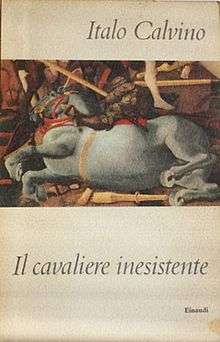The Nonexistent Knight
 First italian edition cover | |
| Author | Italo Calvino |
|---|---|
| Original title | Il cavaliere inesistente |
| Cover artist | Paolo Uccello, The Battle of San Romano |
| Language | Italian |
Publication date | 1959 |
Published in English | 1962 |
The Nonexistent Knight (Italian: Il cavaliere inesistente) is an allegorical fantasy novel by Italo Calvino, first published in Italian 1959 and in English translation in 1962.
The tale explores questions of identity, integration with society, and virtue through the adventures of Agilulf, a medieval knight who exemplifies chivalry, piety, and faithfulness but exists only as an empty suit of armour.
Plot
The Nonexistent Knight is set in the time of Charlemagne, and draws material from the literary cycle known as the Matter of France, referencing Ariosto's Orlando Furioso. Agilulf is a righteous, perfectionist, faithful and pious knight with only one shortcoming: he doesn't exist. Inside his empty armour is an echoing voice that reverberates through the metal. Nevertheless, he serves the army of a Christian king out of "goodwill and faith in the holy cause".
Themes
Agilulf exists only as the fulfilment of the rules and protocols of knighthood. This theme is strongly connected to modern conditions: Agilulf has been described as "the symbol of the 'robotized' man, who performs bureaucratic acts with near-absolute unconsciousness."[1] The romance satirises Agilulf as the ideal man yet nonexistent along with many suggestions that Sister Theodora is making up most of the story. In the end, she understands that such a perfect knight could live only in one's imagination.
The idea of confusion of one's own identity with others and the outside world continued to be developed in Calvino's later works.[2]
Reception
The Nonexistent Knight was collected together with The Cloven Viscount and The Baron in the Trees in a single volume, Our Ancestors, for which Calvino was awarded the Salento Prize in 1960.[3] The book was adapted into an animated film by Italian director Pino Zac in 1970.[4]
References
Notes
- ↑ Hagen, Margareth (February 2002). "La seduzione del cavaliere inesistente" (PDF). Romansk Forum. 16: 875–885. Retrieved 2008-09-11.
- ↑ Vidal, Gore (May 30, 1974). "Fabulous Calvino". The New York Review of Books. 21 (9). Retrieved 2008-07-28.
- ↑ Weiss, Beno (1993). Understanding Italo Calvino. University of South Carolina Press. pp. xiv. ISBN 0-87249-858-1. Retrieved 2008-07-28.
- ↑ Healy, Robin Patrick (1998). Twentieth-century Italian Literature in English Translation. University of Toronto Press. p. 126. ISBN 0-8020-0800-3. Retrieved 2008-07-28.
Bibliography
- McLaughlin, Martin (1998). Italo Calvino. Edinburgh University Press. ISBN 0-7486-0917-2. Retrieved 2012-08-03.